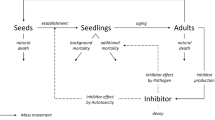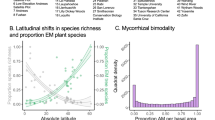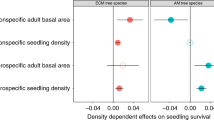Abstract
The accumulation of species-specific enemies around adults is hypothesized to maintain plant diversity by limiting the recruitment of conspecific seedlings relative to heterospecific seedlings1,2,3,4,5,6. Although previous studies in forested ecosystems have documented patterns consistent with the process of negative feedback7,8,9,10,11,12,13,14,15,16, these studies are unable to address which classes of enemies (for example, pathogens, invertebrates, mammals) exhibit species-specific effects strong enough to generate negative feedback17, and whether negative feedback at the level of the individual tree is sufficient to influence community-wide forest composition. Here we use fully reciprocal shade-house and field experiments to test whether the performance of conspecific tree seedlings (relative to heterospecific seedlings) is reduced when grown in the presence of enemies associated with adult trees. Both experiments provide strong evidence for negative plant–soil feedback mediated by soil biota. In contrast, above-ground enemies (mammals, foliar herbivores and foliar pathogens) contributed little to negative feedback observed in the field. In both experiments, we found that tree species that showed stronger negative feedback were less common as adults in the forest community, indicating that susceptibility to soil biota may determine species relative abundance in these tropical forests. Finally, our simulation models confirm that the strength of local negative feedback that we measured is sufficient to produce the observed community-wide patterns in tree-species relative abundance. Our findings indicate that plant–soil feedback is an important mechanism that can maintain species diversity and explain patterns of tree-species relative abundance in tropical forests.
This is a preview of subscription content, access via your institution
Access options
Subscribe to this journal
Receive 51 print issues and online access
$199.00 per year
only $3.90 per issue
Buy this article
- Purchase on Springer Link
- Instant access to full article PDF
Prices may be subject to local taxes which are calculated during checkout



Similar content being viewed by others
References
Janzen, D. H. Herbivores and the number of tree species in tropical forests. Am. Nat. 104, 501–528 (1970)
Connell, J. H. in Dynamics of Populations (eds den Boer, P. J. & Gradwell, G. R.) 298–312 (Center for Agricultural Publication and Documentation, 1971)
Bever, J. D. Feedback between plants and their soil communities in an old field community. Ecology 75, 1965–1977 (1994)
Klironomos, J. N. Feedback with soil biota contributes to plant rarity and invasiveness in communities. Nature 417, 67–70 (2002)
Kulmatiski, A., Beard, K. H., Stevens, J. R. & Cobbold, S. M. Plant-soil feedback: a meta-analytical review. Ecol. Lett. 11, 980–992 (2008)
Carson, W. P., Anderson, J. T., Leigh, E. G. & Schnitzer, S. A. in Tropical Forest Community Ecology (eds Carson, W. P. & Schnitzer, S. A.) 210–241 (Wiley-Blackwell, 2008)
Webb, C. O. & Peart, D. R. Seedling density dependence promotes coexistence of Bornean rain forest trees. Ecology 80, 2006–2017 (1999)
Harms, K. E., Wright, S. J., Calderón, O., Hernández, A. & Herre, A. E. Pervasive density-dependent recruitment enhances seedling diversity in a tropical forest. Nature 404, 493–495 (2000)
Lambers, H. R. L., Clark, J. S. & Beckage, B. Density-dependent mortality and the latitude gradient in species diversity. Nature 417, 732–735 (2002)
Peters, H. A. Neighbour-regulated mortality: the influence of positive and negative density dependence on tree populations in species-rich tropical forests. Ecol. Lett. 6, 757–765 (2003)
Wills, C. et al. Nonrandom processes maintain diversity in tropical forests. Science 311, 527–531 (2006)
Comita, L. S. & Hubbell, S. P. Local neighborhood and species’ shade tolerance influence survival in a diverse seedling bank. Ecology 90, 328–334 (2009)
Packer, A. & Clay, K. Soil pathogens and spatial patterns of seedling mortality in a temperate tree. Nature 404, 278–281 (2000)
Augspurger, C. K. & Kelly, C. K. Pathogen mortality of tropical tree seedlings: experimental studies of the effects of dispersal distance, seedling density, and light conditions. Oecologia 61, 211–217 (1984)
Hood, L. A., Swaine, M. D. & Mason, P. A. The influence of spatial patterns of damping-off disease and arbuscular mycorrhizal colonization on tree seedling establishment in Ghanaian tropical forest soil. J. Ecol. 92, 816–823 (2004)
Bell, T., Freckleton, R. P. & Lewis, O. T. Plant pathogens drive density-dependent seedling mortality in a tropical tree. Ecol. Lett. 9, 569–574 (2006)
Bever, J. D., Kristi, M. W. & Antonovics, J. Incorporating the soil community into plant population dynamics: the utility of the feedback approach. J. Ecol. 85, 561–573 (1997)
Bever, J. D. Soil community feedback and the coexistence of competitors: conceptual frameworks and empirical tests. New Phytol. 157, 465–473 (2003)
Adler, R. A. & Muller-Landau, H. C. When do localized natural enemies increase species richness? Ecol. Lett. 8, 438–447 (2005)
Petermann, J. S., Fergus, A. J. F., Turnbull, L. A. & Schmid, B. Janzen-Connell effects are widespread and strong enough to maintain diversity in grasslands. Ecology 89, 2399–2406 (2008)
McCarthy-Neumann, S. & Kobe, R. K. Conspecific plant-soil feedbacks reduce survivorship and growth of tropical tree seedlings. J. Ecol. 98, 396–407 (2010)
Hubbell, S. P., Ahumada, J. A., Condit, R. & Foster, R. B. Local neighborhood effects on long-term survival of individual trees in a neotropical forest. Ecol. Res. 16, 859–875 (2001)
Mills, K. M. & Bever, J. D. Maintenance of diversity within plant communities: soil pathogens as agents of negative feedback. Ecology 79, 1595–1601 (1998)
Kardol, P., Cornips, N. J., van Kempen, M. M. L., Bakx-Shotman, J. M. T. & van der Putten, W. H. Microbe-mediated plant-soil feedback causes historical contingency effects in plant community assembly. Ecol. Monogr. 77, 147–162 (2007)
Bever, J. D. Negative feedback within a mutualism: host-specific growth of mycorrhizal fungi reduces plant benefit. Proc. R. Soc. Lond. B 269, 2595–2601 (2002)
De Deyn, G. B. et al. Soil invertebrate fauna enhances grassland succession and diversity. Nature 442, 711–713 (2003)
Comita, L. S., Muller-Landau, H. C., Aguilar, S. & Hubbell, S. P. Asymmetric density dependence shapes species abundances in a tropical tree community. Science 10.1126/science.1190772 (in the press)
Hubbell, S. P. The Unified Neutral Theory of Biodiversity and Biogeography (Princeton Univ. Press, 2001)
Roesch, L. F. W. et al. Pyrosequencing enumerates and contrasts soil microbial diversity. ISME J. 1, 283–290 (2007)
Connell, J. H., Tracey, J. G. & Webb, L. J. Compensatory recruitment, growth, and mortality as factors maintaining rain forest tree diversity. Ecol. Monogr. 54, 141–164 (1984)
Acknowledgements
We thank G. Adler, M. Kaspari, E. Leigh, T. Lambert, I. Rubinoff, E. Tanner, M. Tobin, B. Turner, S. Van Bael and N. Wurzburger for providing discussions and comments on the manuscript. R. Kolodziej, K. Meyer, K. McElligott and T. Shirshac provided greenhouse and field assistance. Logistical support was provided by the Smithsonian Tropical Research Institute. The Center of Tropical Forest Science provided BCI tree abundance data published online at https://ctfs.arnarb.harvard.edu/webatlas/datasets/bci/abundance. This study was supported by a Smithsonian Tropical Research Institute (STRI) postdoctoral fellowship to S.A.M., a University of Wisconsin–Milwaukee (UWM) Research Growth Initiative grant to S.A.S., a fellowship from the UWM Research Foundation, and a grant from the National Science Foundation to J.D.B. We thank I. Rubinoff for his support of the STRI Soil Initiative.
Author information
Authors and Affiliations
Contributions
S.A.M. designed and conducted the experiments, analysed the data and wrote the first draft. S.A.S., E.A.H. and J.D.B. provided important revisions. J.D.B. and K.M.L.M. developed the simulation. M.C.V. and E.I.S. provided essential field support.
Corresponding author
Ethics declarations
Competing interests
The authors declare no competing financial interests.
Supplementary information
Supplementary Information
This file contains Supplementary Tables 1-3, Supplementary Figures 1-2 with legends, a Supplementary Discussion, and Supplementary Equations. (PDF 256 kb)
Rights and permissions
About this article
Cite this article
Mangan, S., Schnitzer, S., Herre, E. et al. Negative plant–soil feedback predicts tree-species relative abundance in a tropical forest. Nature 466, 752–755 (2010). https://doi.org/10.1038/nature09273
Received:
Accepted:
Published:
Issue Date:
DOI: https://doi.org/10.1038/nature09273
This article is cited by
-
Mind the blind spot: lessons from fungal community sequencing in a plant–soil feedback experiment
CABI Agriculture and Bioscience (2023)
-
Modelling how negative plant–soil feedbacks across life stages affect the spatial patterning of trees
Scientific Reports (2023)
-
Plant–soil feedback effects on conspecific and heterospecific successors of annual and perennial Central European grassland plants are correlated
Nature Plants (2023)
-
Negative plant-soil feedbacks disproportionally affect dominant plants, facilitating coexistence in plant communities
npj Biodiversity (2023)
-
Effects of moisture and density-dependent interactions on tropical tree diversity
Nature (2023)
Comments
By submitting a comment you agree to abide by our Terms and Community Guidelines. If you find something abusive or that does not comply with our terms or guidelines please flag it as inappropriate.



